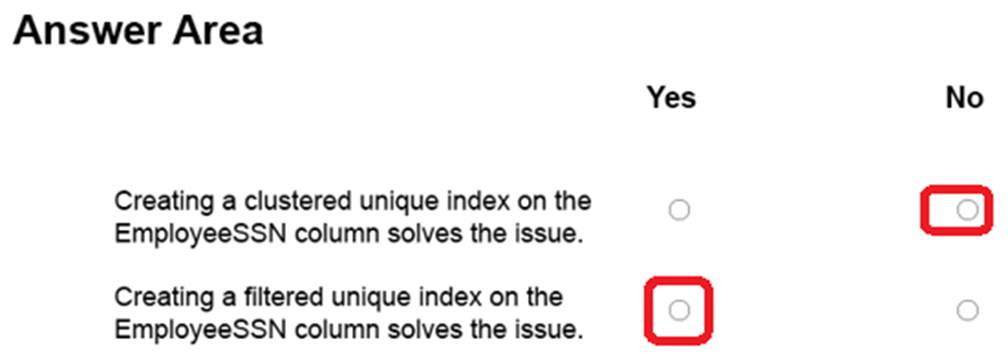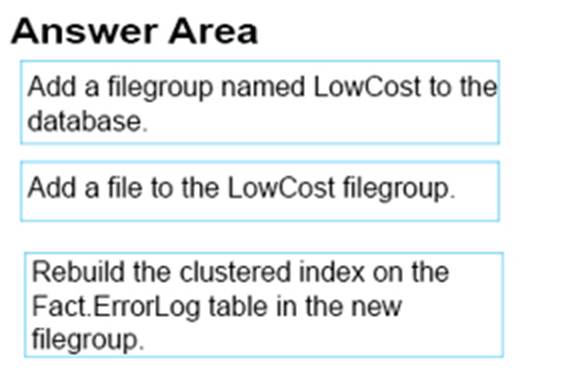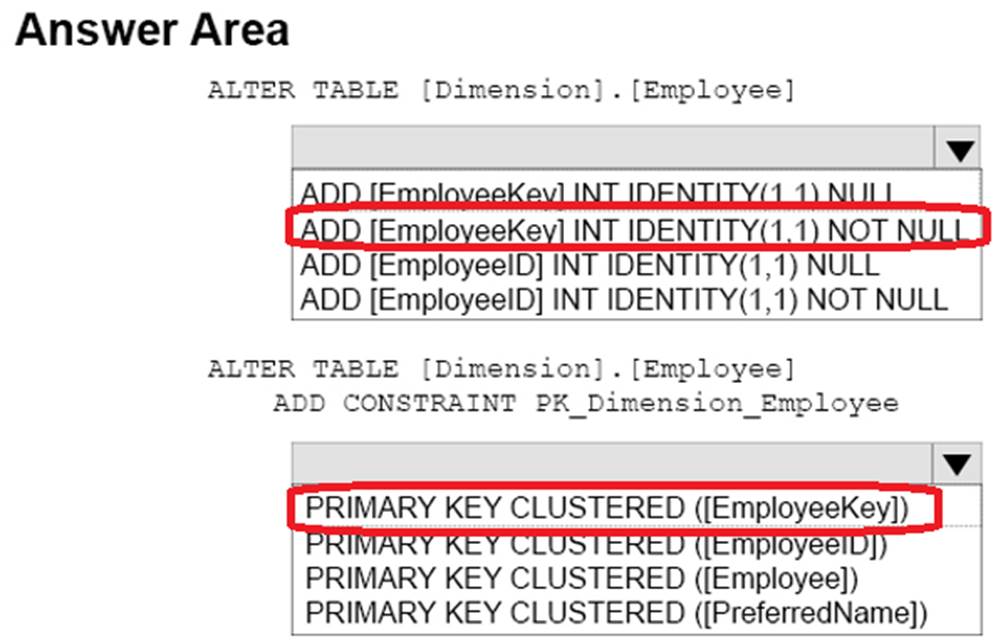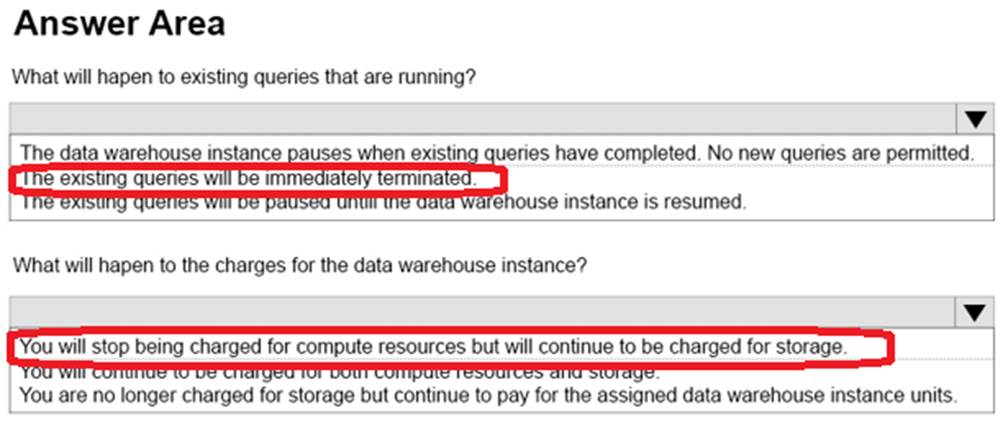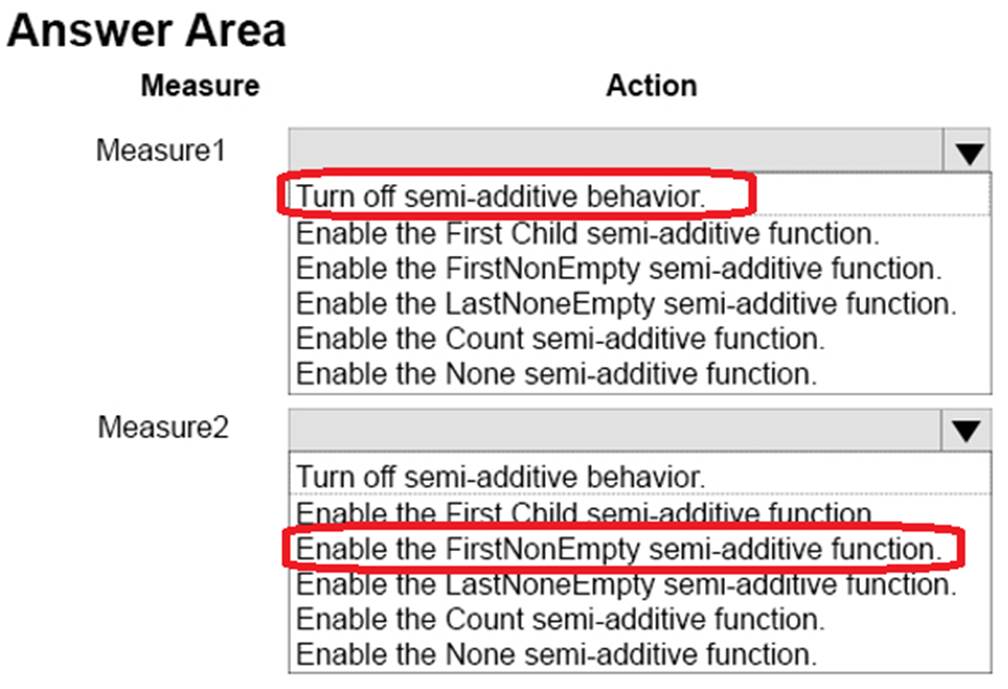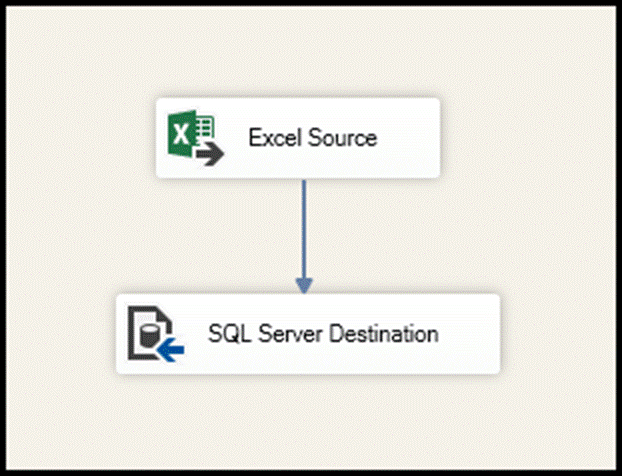Microsoft 70-767 Implementing a SQL Data Warehouse Online Training
Microsoft 70-767 Online Training
The questions for 70-767 were last updated at Oct 29,2025.
- Exam Code: 70-767
- Exam Name: Implementing a SQL Data Warehouse
- Certification Provider: Microsoft
- Latest update: Oct 29,2025
HOTSPOT
You manage a data warehouse in a Microsoft SQL Server instance. Company employee information is imported from the human resources system to a table named Employee in the data warehouse instance. The Employee table was created by running the query shown in the Employee Schema exhibit. (Click the Exhibit button.)
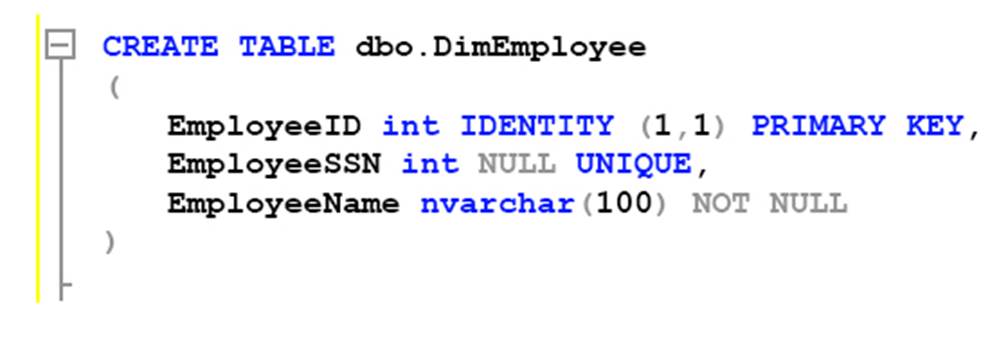
The personal identification number is stored in a column named EmployeeSSN. All values in the EmployeeSSN column must be unique.
When importing employee data, you receive the error message shown in the SQL Error exhibit. (Click the Exhibit button.).

You determine that the Transact-SQL statement shown in the Data Load exhibit in the cause of the error. (Click the Exhibit button.)

You remove the constraint on the EmployeeSSN column. You need to ensure that values in the EmployeeSSN column are unique.
For each of the following statements, select Yes if the statement is true. Otherwise, select No.
NOTE: Each correct selection is worth one point.
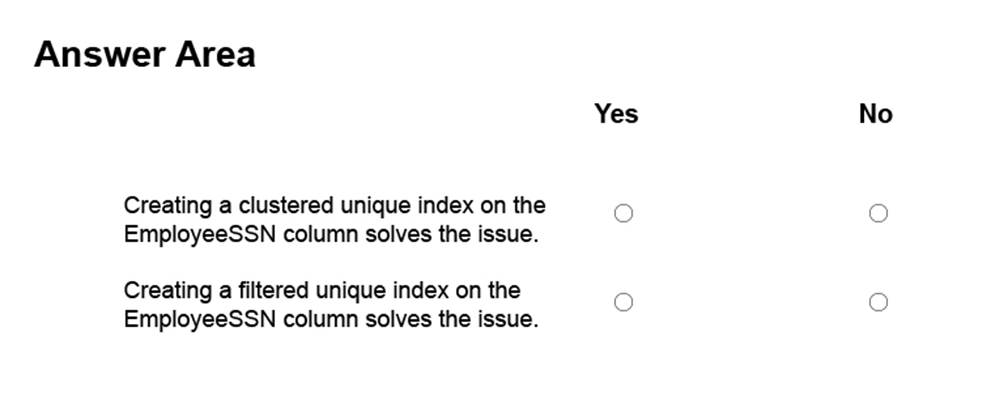
DRAG DROP
You have a data warehouse.
You need to move a table named Fact.ErrorLog to a new filegroup named LowCost.
Which three actions should you perform in sequence? To answer, move the appropriate actions from the list of actions to the answer area and arrange them in the correct order.
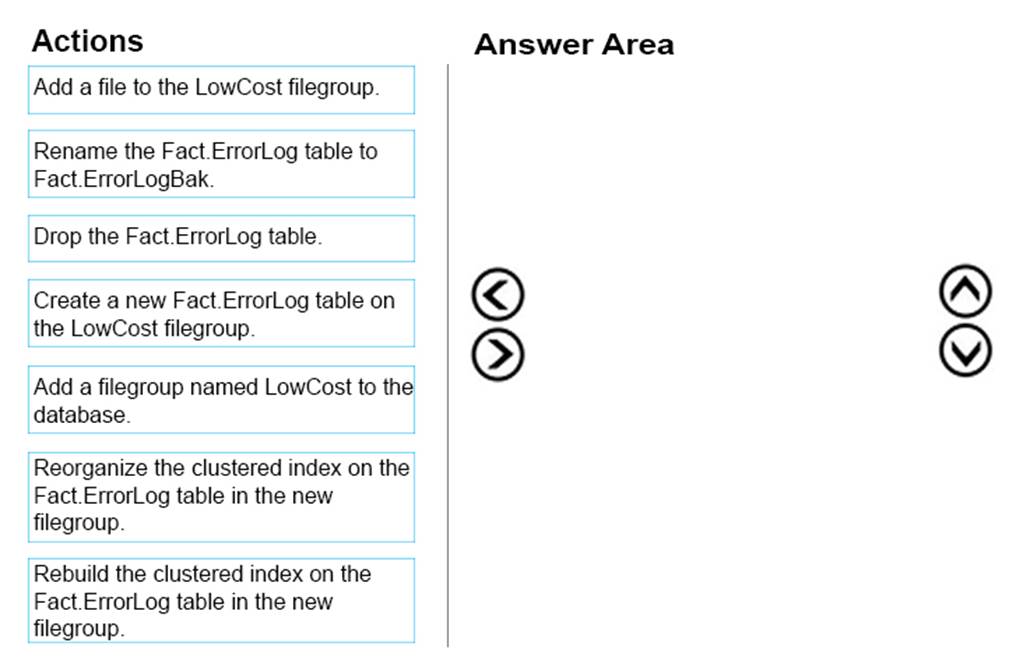
HOTSPOT
Your company has a Microsoft SQL Server data warehouse instance. The human resources department assigns all employees a unique identifier. You plan to store this identifier in a new table named Employee.
You create a new dimension to store information about employees by running the following Transact-SQL statement:
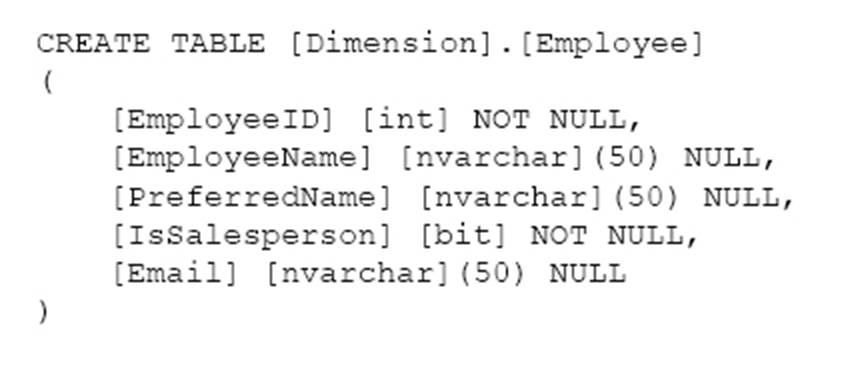
You have not added data to the dimension yet. You need to modify the dimension to implement a new column named [EmployeeKey]. The new column must use unique values.
How should you complete the Transact-SQL statements? To answer, select the appropriate Transact-SQL segments in the answer area.
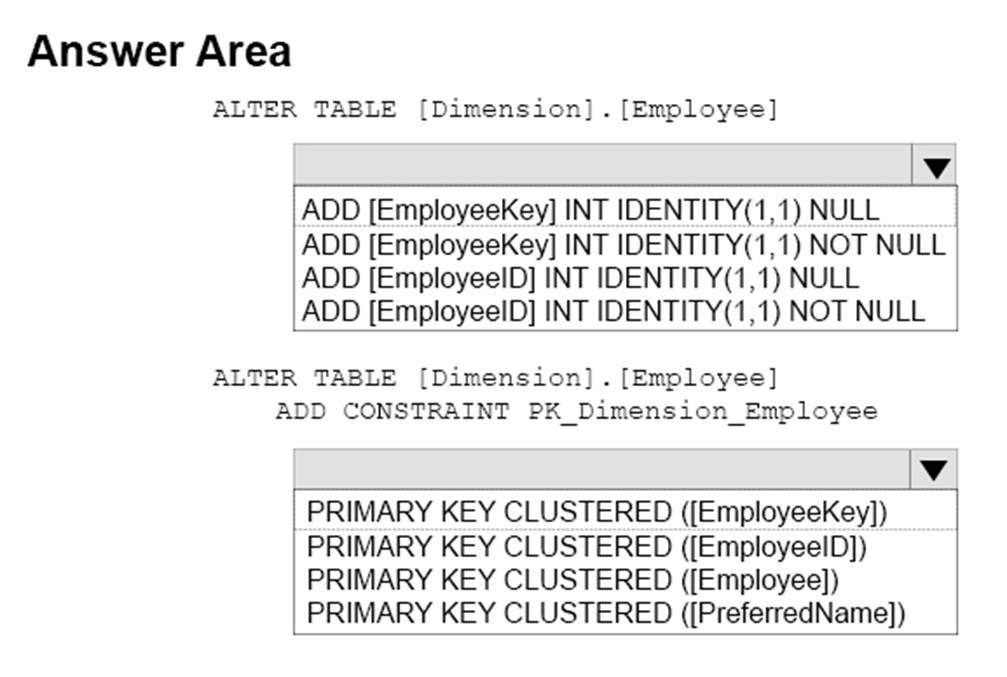
HOTSPOT
You deploy a Microsoft Azure SQL Data Warehouse instance. The instance must be available eight hours each day.
You need to pause Azure resources when they are not in use to reduce costs.
What will be the impact of pausing resources? To answer, select the appropriate options in the answer area.
NOTE: Each correct selection is worth one point.
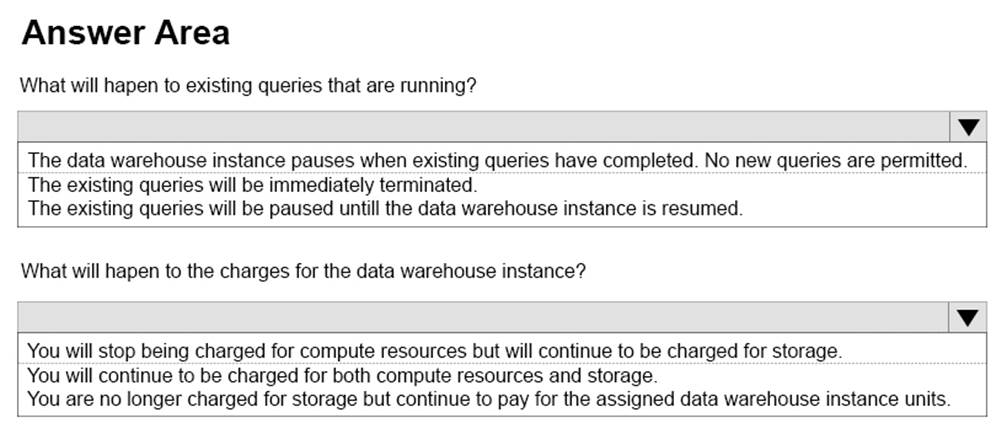
HOTSPOT
You have a Microsoft SQL Server Data Warehouse instance that uses SQL Server Analysis Services (SSAS). The instance has a cube containing data from an on-premises SQL Server instance. A measure named Measure1 is configured to calculate the average of a column.
You plan to change Measure1 to a full additive measure and create a new measure named Measure2 that evaluates data based on the first populated row.
You need to configure the measures.
What should you do? To answer, select the appropriate options in the answer area.
NOTE: Each correct selection is worth one point.
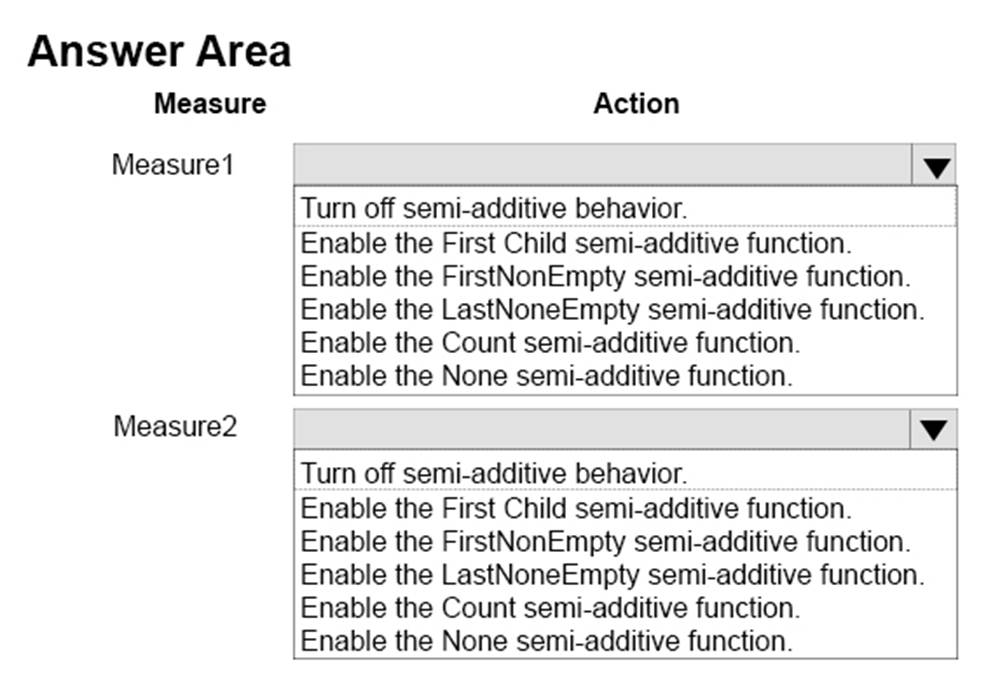
Note: This question is part of a series of questions that use the same or similar answer choices. An answer choice may be correct for more than one question in the series. Each question is independent of the other questions in this series. Information and details provided in a question apply only to that question.
You are a database administrator for an e-commerce company that runs an online store. The company has three databases as described in the following table.

You plan to load at least one million rows of data each night from DB1 into the OnlineOrder table. You must load data into the correct partitions using a parallel process.
You create 24 Data Flow tasks. You must place the tasks into a component to allow parallel load. After all of the load processes compete, the process must proceed to the next task.
You need to load the data for the OnlineOrder table.
What should you use?
- A . Lookup transformation
- B . Merge transformation
- C . Merge Join transformation
- D . MERGE statement
- E . Union All transformation
- F . Balanced Data Distributor transformation
- G . Sequential container
- H . Foreach Loop container
Note: This question is part of a series of questions that use the same or similar answer choices. An answer choice may be correct for more than one question in the series. Each question is independent of the other questions in this series. Information and details provided in a question apply only to that question.
You are a database administrator for an e-commerce company that runs an online store. The company has the databases described in the following table.

Each day, you publish a Microsoft Excel workbook that contains a list of product names and current prices to an external website. Suppliers update pricing information in the workbook. Each supplier saves the workbook with a unique name.
Each night, the Products table is deleted and refreshed from MDS by using a Microsoft SQL Server Integration Services (SSIS) package. All files must be loaded in sequence.
You need to add a data flow in an SSIS package to perform the Excel files import in the data warehouse.
What should you use?
- A . Lookup transformation
- B . Merge transformation
- C . Merge Join transformation
- D . MERGE statement
- E . Union All transformation
- F . Balanced Data Distributor transformation
- G . Sequential container
- H . Foreach Loop container
Note: This question is part of a series of questions that use the same or similar answer choices. An answer choice may be correct for more than one question in the series. Each question is independent of the other questions in this series. Information and details provided in a question apply only to that question.
You are a database administrator for an e-commerce company that runs an online store. The company has the databases described in the following table.

Each week, you import a product catalog from a partner company to a staging table in DB2.
You need to create a stored procedure that will update the staging table by inserting new products and deleting discontinued products.
What should you use?
- A . Lookup transformation
- B . Merge transformation
- C . Merge Join transformation
- D . MERGE statement
- E . Union All transformation
- F . Balanced Data Distributor transformation
- G . Sequential container
- H . Foreach Loop container
Note: This question is part of a series of questions that use the same or similar answer choices. An answer choice may be correct for more than one question in the series. Each question is independent of the other questions in this series. Information and details provided in a question apply only to that question.
You are a database administrator for an e-commerce company that runs an online store. The company has the databases described in the following table.

Each day, data from the table OnlineOrder in DB2 must be exported by partition. The tables must not be locked during the process.
You need to write a Microsoft SQL Server Integration Services (SSIS) package that performs the data export.
What should you use?
- A . Lookup transformation
- B . Merge transformation
- C . Merge Join transformation
- D . MERGE statement
- E . Union All transformation
- F . Balanced Data Distributor transformation
- G . Sequential container
- H . Foreach Loop container
Note: This question is part of a series of questions that use the same or similar answer choices. An answer choice may be correct for more than one question in the series. Each question is independent of the other questions in this series. Information and details provided in a question apply only to that question.
You are a database administrator for an e-commerce company that runs an online store. The company has the databases described in the following table.

Product prices are updated and are stored in a table named Products on DB1. The Products table is deleted and refreshed each night from MDS by using a Microsoft SQL Server Integration Services (SSIS) package. None of the data sources are sorted.
You need to update the SSIS package to add current prices to the Products table.
What should you use?
- A . Lookup transformation
- B . Merge transformation
- C . Merge Join transformation
- D . MERGE statement
- E . Union All transformation
- F . Balanced Data Distributor transformation
- G . Sequential container
- H . Foreach Loop container
Latest 70-767 Dumps Valid Version with 136 Q&As
Latest And Valid Q&A | Instant Download | Once Fail, Full Refund

